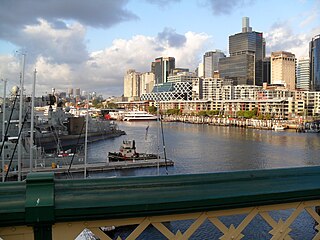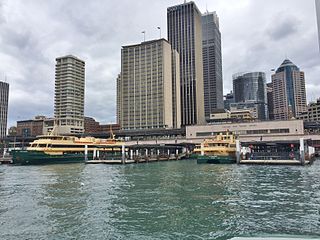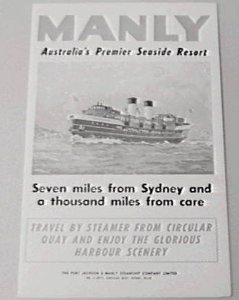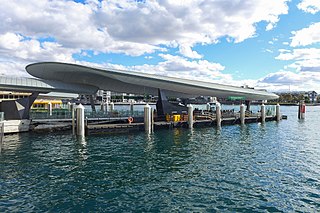
Circular Quay is a harbour, former working port and now international passenger shipping port, public piazza and tourism precinct, heritage area, and transport node located in Sydney, New South Wales, Australia on the northern edge of the Sydney central business district on Sydney Cove, between Bennelong Point and The Rocks. It is part of the local government area of the City of Sydney.

Circular Quay railway station is a heritage-listed elevated commuter rail station that is located on the City Circle route, serving the Circular Quay precinct of the Sydney central business district in New South Wales, Australia. It is served by Sydney Trains T2 Inner West & Leppington, T3 Bankstown and T8 Airport & South line services.

Kirribilli is a suburb of Sydney, New South Wales, Australia. One of the city's most established and affluent neighbourhoods, it is located three kilometres north of the Sydney central business district, in the local government area administered by North Sydney Council. Kirribilli is a harbourside suburb, sitting on the Lower North Shore of Sydney Harbour. Kirribilli House is one of the two official residences of the Prime Minister of Australia

King Street Wharf, is a mixed-use tourism, commercial, residential, retail and maritime development on the eastern shore of Darling Harbour, an inlet of Sydney Harbour, Australia. Located on the western side of the city's central business district, the complex served as a maritime industrial area in the early and mid 20th century. It was redeveloped as part of extensive urban renewal projects around Sydney Harbour in the 1980s and 90s. The complex is host to a cluster of nine wharves, with the first two wharves currently in use by private ferry operator Captain Cook Cruises and a third recently decommissioned by Sydney Ferries.

Sydney Ferries is the public transport ferry network serving the city of Sydney, New South Wales. Services operate on Sydney Harbour and the connecting Parramatta River. The network is controlled by the New South Wales Government's transport authority, Transport for NSW, and is part of the authority's Opal ticketing system. In 2017–18, 15.3 million passenger journeys were made on the network.

Circular Quay Ferry Wharf is a complex of wharves at Circular Quay, on Sydney Cove, that serves as the hub for the Sydney Harbour ferry network.

Manly ferry services operate on Sydney Harbour connecting the Sydney suburb of Manly with Circular Quay in the CBD a journey of seven nautical miles.

The Port Jackson and Manly Steamship Company (PJ&MSC) was a publicly listed company that operated the Manly ferries in Sydney, Australia. After being taken over by Brambles Industries, the ferry service was eventually taken over by the State Government and is now part of Sydney Ferries.

Pyrmont Bay ferry wharf is located on the western side of Darling Harbour serving the inner-city Sydney suburb of Pyrmont. It is located adjacent to the Australian National Maritime Museum and close to The Star Casino.

Rose Bay ferry wharf is located on the southern side of Sydney Harbour serving the Sydney suburb of Rose Bay.
Sydney Fast Ferries operated high-speed ferry services on Port Jackson between Circular Quay and Manly from April 2010 until March 2015.

Manly Fast Ferry is an Australian ferry operator that services the areas of Botany Bay and Port Jackson.

Barangaroo ferry wharf is a ferry wharf located on the eastern side of Darling Harbour, in Sydney, Australia. The wharf is the major public transport link of the Barangaroo precinct, situated west of the Sydney central business district. The complex consists two wharves, with provision for a third wharf in the future. It is serviced by Sydney Ferries' F3 Paramatta River and F4 Pyrmont Bay services. The wharf opened on 26 June 2017.

The Pyrmont Bay ferry service, officially known as F4 Pyrmont Bay, is a commuter ferry service in Sydney, New South Wales. Part of the Sydney Ferries network, it is operated by Transdev Sydney Ferries and services the Lavender Bay and Darling Harbour areas. It began operation on 25 October 2020, and replaced the western half of the F4 Cross Harbour ferry service. Emerald-class ferries and SuperCat ferries operate the service.

The Overseas Passenger Terminal (OPT), known officially as the Sydney Cove Passenger Terminal, is a public passenger terminal servicing cruise ships and ocean liners located in Circular Quay, Sydney, Australia. Whilst commercial shipping operations on and around the site date from 1792, the current primary structure and waterfront promenade date from 1958, with subsequent on-going alterations and land reclamation throughout the latter part of the 20th century. The current design retains the black steel portal frame trusses of the original 1958 structure, with major additions completed in 1988 in the Post-War International Style through the collaboration of Sydney architects Lawrence Nield and Peter Tonkin.
The Mosman Bay ferry service is a commuter ferry route in Sydney, New South Wales, Australia. Part of the Sydney Ferries network, it serves several Lower North Shore suburbs around Mosman Bay.

The Freshwater class is a class of ferry operating the Manly ferry service between Circular Quay and Manly on Sydney Harbour. The ferries are owned by the Government of New South Wales and operated by Transdev Sydney Ferries under the government's Sydney Ferries brand.

The Sydney Cove Railings are heritage-listed railings located at the Circular Quay Concourse, Circular Quay East and West, in the inner city Sydney suburbs of Dawes Point, The Rocks and the Sydney central business district, in the City of Sydney local government area of New South Wales, Australia. It was built from 1900. It is also known as Part of Sydney Cove. The property is owned by Property NSW, an agency of the Government of New South Wales. It was added to the New South Wales State Heritage Register on 10 May 2002.

Sydney Harbour ferry services date back to the first years of Sydney's European settlement. Slow and sporadic boats ran along the Parramatta River from Sydney to Parramatta and served the agricultural settlements in between. By the mid-1830s, speculative ventures established regular services. From the late-nineteenth century the North Shore developed rapidly. A rail connection to Milsons Point took alighting ferry passengers up the North Shore line to Hornsby, New South Wales via North Sydney. Without a bridge connection, increasingly large fleets of steamers serviced the cross harbour routes and in the early twentieth century, Sydney Ferries Limited was the largest ferry operator in the world.


















